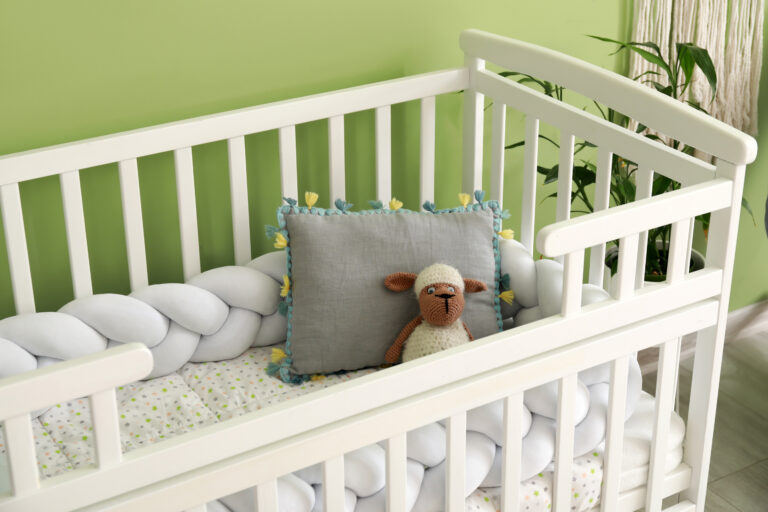If you're pregnant or have had a child before, you were likely told about crib bumpers. You might have been told they were a necessity for keeping your baby safe, or that you should avoid them altogether. So, which one is it? Research and studies conducted within the last 30 years indicate that crib bumpers actually do more harm than good.
Are crib bumpers safe?
What are crib bumpers?
Crib bumpers are soft, fabric pads that line the inside of your baby’s crib. They’re essentially a cozy ring of plush padding intended to keep your baby’s bed cozy and protect them from crib-related injuries. Most notably, banging their heads or getting stuck in between the crib bars. They typically start at crib mattress level and rise either halfway up or to the top of the crib itself.
It's easy to understand the appeal, which is why they can be misleading. Crib bumpers promise a safe sleep environment – however, research indicates that crib bumpers are not only unnecessary, but they’re also putting your baby at risk.

Are crib bumpers safe?
If your household has any bumpers lying around, or your crib currently includes padded bumpers, the recommendation is to remove them or repurpose them.
The U.S. Consumer Product Safety Commission (CPSC) has associated 107 infant deaths and 282 non-fatal injuries between 1990 and 2019 with padded crib bumpers. Research indicates that these bumpers can cause suffocation, entrapment, and strangulation. Even though they’re banned in the U.S., they’re still widely sold and manufactured in Australia.
Babies are likely to roll lots between the ages of four and nine months. If their crib has a bumper, they’re rolling face-first into what is essentially a pillow. Since they do not have the motor skills to turn their neck in another direction, it's easy for them to suffocate. Most bumpers have ties that secure them to the bars of the crib, which can also put your little one at risk of strangulation.
The American Academy of Pediatrics (AAP) has urged parents to steer clear of bumpers altogether, as there is no sufficient evidence to prove crib bumpers prevent major injuries.
Cribs built and sold in 2023 are arguably much better than those in the 80s and 90s. In 2011, new safety standards behind the production of cribs in the U.S. took effect. As a result, mattress supports are now stronger, safety tests are more rigorous, and many cribs now have bars that are closer together so babies can’t stick their heads between the slats and get stuck.
So – if crib bumpers are so bad, why are they still around?
In 2015, the Juvenile Products Manufacturers Association (JPMA) stated that ‘At no time has the crib bumper been cited as the sole cause of an infant’s death.’
The AAP still advises against using any kind of bumper, and a 2016 study published in The Journal of Pediatrics highlighted that deaths related to bumpers are still rising. Even though both bodies have different recommendations, we’d agree it's best to consult your baby’s healthcare provider or steer clear of bumpers altogether.
Why are they banned?
As of May 2022, crib bumpers are officially banned in the United States. The Safe Sleep for Babies Act was signed into law last year, prohibiting manufacturers from selling crib bumpers and inclined sleepers in the United States. The act aims to clarify that bumpers are generally unsafe and make it easier for new parents to protect their newborns.
So what does this mean for mums in Australia? Even though they can be purchased at many major Australian retailers, we’d recommend avoiding all bumper products.
A study conducted in 2007 highlights how dangerous these bumpers truly are. For many years, consumers thought the bumpers were safe for sleep as that’s how they were marketed. The authors of the study assessed various injuries that could have been prevented by the bumpers, and the result was mostly minor injuries like bruises. While there are some cases where the baby presented with a broken arm or leg due to getting caught in the slats, the authors stated that the bumper wouldn't necessarily prevent those injuries.

Creating a safe sleeping environment for your baby
As of 2016, the annual rate of crib-bumper-related deaths has nearly tripled. New parents must understand how to create a safe sleeping environment for their baby to keep them safe and prevent sudden infant death.
The safest sleeping environment is a firm mattress with nothing but a well-fitted sheet. No blankets, pillows, stuffed animals, bumpers, or anything that can obstruct their breathing.
While it might be tempting to grab something second-hand to keep costs down, your baby’s bed should meet current safety standards. Their cot should preferably be made after 2011, which is when new safety standards in the U.S. took effect. Cribs manufactured before then are likely to have drop-down sides and wider slats which can pose a safety risk to your newborn. If you’re unsure, measure the side slats and ensure the gap is not greater than 6cm. All cribs manufactured after 2011 will probably meet this requirement but it's always best to double-check.
Make sure your little one sleeps on their back and that the surface they’re sleeping on is flat and firm. Ensure the mattress fits tightly and there's no room between the bedding and crib side where they can shuffle into. Additionally, don't let them sleep in swings or car seats, as this can pose the same risk as inclined sleepers.
What about mesh bumpers and inclined sleepers?
In response to the safety concerns regarding bumpers, some retailers now sell breathable mesh bumpers. However, these bumpers account for 13% of all crib bumper deaths, still posing the same risks as traditional bumpers.
Inclined baby sleepers are also not a suitable replacement, as they can pose a suffocation risk, hence why they’re banned in the United States. CPSC reported 73 deaths in 1,108 incidents involving inclined sleepers between 2015 and 2019.
